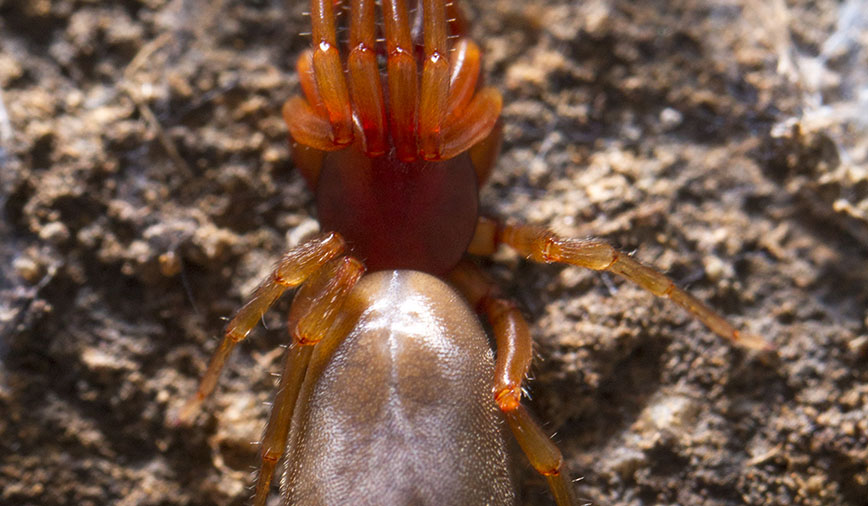The woodlouse spider is noted for its deep red coloring and its large fangs, or chelicerae. Our cool and wet summer has led to an abundance of woodlice—a.k.a. sowbugs and roly-polies—and hence an abundance of woodlouse spiders.
August 29, 2014
Woodlouse Spider
Lousy.
It’s a crummy term, even under the best of circumstances.
That is, unless you happen to be a wodlouse spider.
Lately we’ve been seeing and hearing a lot about this common species, no doubt thanks to an abundance of its favored (and namesake) prey, the woodlouse. With all the rain and generally cool temperatures we’ve been having, Kane County is lousy with woodlice.
Before we go any further, I should probably explain. Woodlouse is a generic term that actually encompasses an entire suborder of isopods, Oniscidea, and consists of about 100 species in North America. Woodlice are variously referred to as roly-polies, pillbugs and sowbugs (but actually are more closely related to shrimp than “bugs,” or insects).
At any rate, 2014 is shaping up to be a banner year for the woodlouse. And when the woodlouse is doing well, so too is the woodlouse spider, Dysdera crocata.
At first glance, this arachnid looks, well, a wee bit scary. In fact, the genus name Dysdera reportedly is from an ancient Greek word that means “hard to fight against.” The spider’s deep maroon legs and cephalothorax stand in sharp contrast to its grayish-yellow abdomen. And its fangs—yow! Even on a young specimen they’re hard to ignore.
But when you stop to consider what these mouthparts, also known as chelicerae, are used for, their heft starts to make sense. Roly-polies and sowbugs are covered with a tough exoskeleton that protects them like a suit of armor. (As an aside, pillbugs belong to the family Armadillidiidae, a not-so-thinly veiled reference to another armored
creature, the armadillo.)
When your prey is encased in the arthropod equivalent of a flak jacket, you need some pretty powerful weapons in your arsenal. Interestingly though, the bite that means death to a roly-poly seldom causes more than minor pain in a human. And even this goes away after about an hour, according to several published sources.
Nonetheless, the spider’s long, sharp, shiny-looking fangs are often what first catch people’s attention. They’re also what prompts people to call or email. Or, sometimes, squish the spider, put it in a Ziploc bag and bring it to Hickory Knolls for identification.
Over the past few months, I’ve received various sorts of requests for identification of these “mystery spiders,” which tend to turn up unexpectedly.
Secretive by nature, they like to hide out in habitat similar to that favored by their prey—dark, damp areas that typically go undisturbed. But when some sort of disturbance does occur—a flower pot is moved, a flagstone is repositioned—the spider and its lair can be uncovered.
Last week, my friend and coworker Brianne found a woodlouse spider of her very own, sitting quite still on the floor in her basement. Bless her heart, despite spiders not being her favorite thing, Brianne brought it in—unharmed–so we all could brush up on our spider identification skills.
That’s right, even though we were pretty sure Brianne had found a woodlouse spider, we couldn’t be absolutely sure right away. There’s another group of spiders, the genus Trachelas, that look very similar to Dysdera. However, while Trachelas has eight eyes, Dysdera has only six—a characteristic that is somewhat unusual in our region. With this in mind, we proceeded to the next step in our study: Take an extremely close look at the spider’s frontal region.
With a lot of contorting, mostly on our part but a little bit by the spider too, we were able to count six, and only six, eyes, thus confirming the i.d.
In the process, we also learned another very important detail: A 10x magnification hand lens will make those chelicerae appear EVEN BIGGER.
Throughout the identification exercise, the spider continually displayed its extreme mobility– a trait that serves it well on its happy hunting grounds. The woodlouse spider captures its prey not with webs, but rather by ambush. It waits quietly inside a silken lair until supper strolls near, then, BAM! It pounces, pierces and feeds.
Knowing it wasn’t fair to keep this magnificent and energetic animal cooped up any longer, we made a few attempts at photos, then went outside to analyze our options for release. The sidewalk? Nah, too sunny. The brick wall? Nope. The highly terrestrial spider definitely did not want to be vertical.
At long last, we chose a shaded spot under an oak tree, where the mulch and rocks provided plenty of dark, damp hiding places. We’re hoping the spider found it perfectly lousy—woodlousy, that is.
Pam Erickson Otto is the manager of nature programs and interpretive services at the Hickory Knolls Discovery Center, a facility of the St. Charles Park District. She can be reached at 630-513-4346 or potto@stcparks.org.

